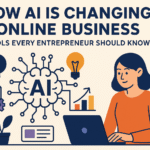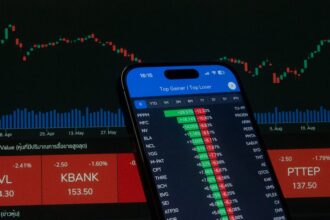From Zero to $10k: A Beginner’s Guide to Building Wealth Online
The dream of building wealth online whispers to millions. It’s the promise of location independence, financial freedom, and escaping the 9-to-5 grind. But for every success story, there are countless others who never get started, lost in a sea of “guru” hype and get-rich-quick schemes that lead nowhere.
The truth is, the path from zero to $10k is not a secret. It’s a systematic process of acquiring valuable skills, providing genuine value, and scaling your efforts. This guide strips away the noise. It’s a practical, actionable blueprint designed for absolute beginners. We won’t promise overnight millions. Instead, we provide the foundational strategies—freelancing, content creation, and digital product sales—that have generated real wealth for real people. By understanding the principles of building wealth online, you can start your journey with clarity and confidence.
Myth-Busting: The Reality of Making Money Online
Before we dive into the strategies, it’s crucial to ground our expectations in reality. The internet is a tool, not a magic wand.
- Myth 1: It’s a get-rich-quick scheme. Reality: Building sustainable online income requires work, consistency, and patience. Your first $100 will likely be harder to earn than your next $10,000.
- Myth 2: You need a revolutionary idea. Reality: You don’t need to invent the next Facebook. You can build a significant income by doing common things uncommonly well. Solving a specific, existing problem is far more profitable than chasing a novel idea.
- Myth 3: It’s completely passive. Reality: While you can build passive income streams, they require active work upfront to create, set up, and maintain. Think of it as planting a tree: it takes effort to dig the hole and plant it, but eventually, it provides shade (income) with less daily work.
Shifting your mindset from a “get-rich” seeker to a “value-creator” is the first and most critical step in your journey to generate income online.
The Foundation: Your Mindset and Preparation
Your internal framework will determine your external results. Prepare your workspace and your mind for success.
1. Cultivating the Right Mindset
Embrace a growth mindset. Believe that your abilities can be developed through dedication and hard work. This view creates a resilience essential for overcoming the inevitable challenges of online entrepreneurship.
2. Setting Up for Success: Your Digital Workspace
- A Dedicated Space: Even a small desk in a quiet corner can serve as your “office,” signaling to your brain that it’s time to work.
- Essential Tools: A reliable computer, high-speed internet, a noise-canceling microphone (if you plan on recording), and a simple notebook for ideas.
- Organization: Use free tools like Google Calendar for scheduling, Trello or Asana for project management, and Notion for note-taking.
3. The 3 Pillars of Online Wealth: Choose Your Path
For beginners, most legitimate online income strategies fall into three core categories. You can start with one and expand later.
- Freelancing & Services: Trading your time and skills for money (e.g., writing, design, coding).
- Content Creation & Audience Building: Creating valuable content (blog, video, podcast) to build an audience and monetize through ads, sponsorships, and affiliates.
- E-commerce & Digital Products: Selling physical products (dropshipping, print-on-demand) or digital goods (e-books, courses, software).
Let’s break down each path in detail.
Path 1: Freelancing & Services – Trade Skills for Cash
This is the fastest way to go from zero to your first dollar online. You are essentially starting a one-person service business.
Step 1: Identify Your Marketable Skill
What can you do that businesses or individuals will pay for? Don’t say “nothing.” Skills are learnable. High-demand beginner-friendly skills include:
- Writing & Content: Blog writing, copywriting, proofreading, ghostwriting.
- Graphic Design: Social media graphics, logos, simple web design (using Canva or Figma).
- Video & Audio: Video editing, podcast editing, voice-over work.
- Tech & Admin: Virtual assistance, data entry, customer service, WordPress management.
Actionable Tip: If you lack a skill, dedicate the next 30-60 days to learning one through free resources on YouTube (free) or structured courses on platforms like Coursera or Skillshare (low cost).
Step 2: Create a Portfolio (Even with Zero Clients)
You can’t get clients without a portfolio, and you can’t get a portfolio without clients. It’s a classic catch-22. Break it by creating “sample” work.
- Writers: Write 2-3 sample blog posts on popular topics.
- Designers: Create mock logos or social media packs for fake companies.
- Editors: Edit a public-domain video or podcast and show the before-and-after.
Host your portfolio for free on Carrd, Contently, or even a simple PDF.
Step 3: Find Your First Clients
This is where most people get stuck. Be proactive.
- Freelance Marketplaces: Platforms like Upwork, Fiverr, and PeoplePerHour are crowded but viable for beginners. The key is to specialize. Instead of being a “writer,” be a “B2B SaaS blog writer.” Craft compelling proposals that focus on the client’s problem, not just your skills.
- Cold Outreach: Find 10 small businesses or startups you’d like to work with. Find their email and send a personalized pitch explaining how you can solve a specific problem you noticed on their website or social media.
- Networking: Leverage LinkedIn. Connect with potential clients, engage with their content, and join relevant groups. Let your network know you’re available for work.
Case Study: Sarah, The Freelance Writer
Sarah was working retail with a degree in English. She had zero online clients. She spent one month:
- Learning: Took a free SEO writing course on YouTube.
- Portfolio: Wrote three sample articles on sustainable living (a personal interest).
- Outreach: She pitched 5 eco-friendly brands per day for two weeks via email and LinkedIn.
Result: She landed two clients within a month: one for $150/article and another for a $500/month blog management retainer. Within 6 months, she had replaced her retail income and was well on her way to her first $10k online.
Path 2: Content Creation & Audience Building – The Long Game
This path involves creating value upfront to build trust and an audience (your “asset”) and then monetizing that trust over time.
Step 1: Choose Your Niche and Platform
Your niche should be at the intersection of what you know/about, what you’re passionate about, and what has a monetizable audience. Avoid overly broad niches like “fitness.” Try “yoga for runners over 40” or “bodyweight workouts for travelers.”
Choose your primary platform:
- YouTube: For video content. High earning potential, but high production effort.
- Blog/SEO: For written content. Fantastic for long-term passive traffic from Google.
- Instagram/TikTok: For short-form visual content. Great for building a community quickly.
- Podcasting: For audio content. Builds a deeply connected, loyal audience.
Step 2: Create Consistent, Value-Driven Content
The algorithm (and your audience) rewards consistency. Create a content calendar. Your primary goal should be to educate, entertain, or inspire with every piece of content. Answer your audience’s questions before they even ask them.
Step 3: Monetize Your Audience
Once you have a steady flow of traffic (even 1,000 loyal followers is a start), you can monetize.
- Advertising: Google AdSense (for blogs), YouTube Partner Program, or platform-specific ads. This is passive but requires large volume.
- Affiliate Marketing: Promote products you use and love and earn a commission on sales. (e.g., Amazon Associates, shareASale, or company-specific programs). This is one of the most powerful ways to make money online for content creators.
- Sponsorships: Brands pay you to feature their product in your content. Rates vary based on your audience size and engagement.
Path 3: E-commerce & Digital Products – Sell Once, Profit Repeatedly
This path involves creating or sourcing a product once and selling it multiple times, leading to higher scalability.
Option A: Digital Products (High Margins, No Inventory)
You create it once, and it sells forever. Ideal for beginners.
- What to sell: E-books, printable planners, online courses, presets, templates, knitting patterns.
- How to sell: Platforms like Gumroad, Sellfy, or Ko-fi make it easy to set up a digital storefront with no technical skills.
- How to market: Use the content creation strategies from Path 2. A blog or YouTube channel is the perfect engine to drive traffic to your digital store.
Option B: Physical Products (Dropshipping & Print-on-Demand)
You don’t hold inventory. When a customer orders, you send the order to a supplier who manufactures and ships it directly.
- Print-on-Demand (POD): You design t-shirts, mugs, posters, etc. A supplier (like Printful or Printify) prints them and ships them only when an order is placed. Low risk.
- Dropshipping: You curate products from suppliers (often on AliExpress) and market them on your store. Requires more investment in advertising and customer service.
Warning: While popular, this model is highly competitive and requires a good understanding of paid advertising (Facebook/Google Ads) to be successful.
Case Study: Mark, The Digital Product Seller
Mark was a graphic designer who loved tabletop games. He noticed people struggled with graphic design for their custom game pieces. He:
- Identified a Problem: No easy-to-use templates for game token assets.
- Created a Product: He spent two weeks creating a high-quality, editable pack of game token templates in Adobe Illustrator and Photoshop.
- Set Up a Store: He listed the product on Gumroad for $29.
- Marketed: He posted about it in 5 relevant Reddit communities and on his small Twitter account.
Result: He made 10 sales the first week ($290). He used that money to run a small $50 Reddit ad, which generated another 30 sales. Within three months, the product had generated over $4,000 with minimal ongoing effort, putting him nearly halfway to his $10k online goal.
The Blueprint: Your 12-Month Action Plan to $10k
This plan consolidates the strategies into a realistic timeline.
Months 1-3: The Foundation & First Dollar
- Focus: Skill acquisition and first sale.
- Action: Choose one path. Learn the necessary core skill. Create your portfolio or first product. Pitch relentlessly or publish content consistently.
- Goal: Earn your first $100 online.
Months 4-6: Building Momentum
- Focus: Systemization and increasing rates.
- Action: Refine your offer based on feedback. For freelancers, raise your prices by 20-30% for new clients. For creators, analyze what content works best and double down. For product sellers, gather testimonials.
- Goal: Reach a consistent $1,000/month in revenue.
Months 7-12: Scaling to $10k
- Focus: Leverage and diversification.
- Action:
- Freelancers: Transition from hourly/project work to retainer packages for stable income. Consider outsourcing small tasks.
- Creators: Launch your first digital product or course to your audience. Pursue higher-tier affiliate programs and sponsorships.
- Product Sellers: Create a second product. Invest more in marketing and SEO.
- Goal: Hit the $10,000 total revenue mark.
Your Journey Starts Now
The path from zero to $10k is a marathon, not a sprint. It’s built on a foundation of value, patience, and consistent action. The digital landscape in 2025 offers more opportunities than ever before for those willing to learn and execute. Whether you choose freelancing, content creation, or e-commerce, the principles remain the same: identify a need, develop a solution, and connect with your audience authentically.
Your journey to building wealth online begins with a single step. Choose one strategy from this guide. Commit to it for the next 90 days. Learn, create, and put yourself out there. That first dollar is waiting for you to claim it.
Frequently Asked Questions (FAQ)
1. How much time do I need to dedicate each day to see results?
Consistency is more important than volume. Dedicating a focused 1-2 hours every day is far more effective than spending 8 hours one day and then doing nothing for a week. In the early stages, expect to invest 10-15 hours per week outside of a full-time job to build momentum.
2. Do I need to pay money to start making money online?
You can start with virtually zero financial investment. Many foundational skills can be learned for free on YouTube and through blog articles. Free tiers of tools like Canva, Google Docs, and Gumroad are powerful enough to get you started. The primary investment required is your time and effort.
3. What is the biggest mistake beginners make?
The most common mistake is “shiny object syndrome”—jumping from one strategy to another without giving any single one enough time to work. They’ll try freelancing for a month, switch to YouTube, then try dropshipping, and never gain mastery in any area. Choosing one path and committing to it for at least 6 months is crucial for success.
4. How do I avoid online scams?
A good rule of thumb is to be wary of any program that promises guaranteed income or huge returns with little effort. Legitimate opportunities focus on teaching you a valuable skill or process. Research the person selling the course or program. Do they have a proven, public track record? Trusted resources often come from established platforms like Coursera, reputable industry blogs backed by companies like [Forbes](https://www.forbes.com/advisor/business/software/learn-how-to-make-money-online/) or [HubSpot](https://blog.hubspot.com/sales/how-to-make-money-online), and communities with authentic user reviews.
5. Is it too late to start building wealth online in 2025?
Absolutely not. While certain platforms and algorithms change, the fundamental principle of the internet—connecting people with solutions—only grows. New niches emerge constantly. The demand for high-quality content, skilled freelancers, and innovative digital products is higher than ever. The best time to start was five years ago; the second-best time is today.








